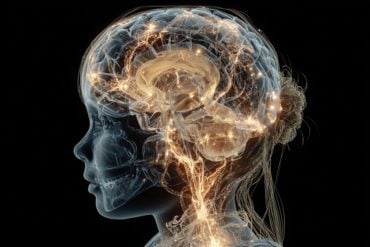Summary: Do you experience the chills when you hear your favorite song? Researchers used EEG to map brain activity while people listened to their favorite tunes. Findings reveal specific brain areas work together to process music, triggering the reward system and increasing dopamine release.
Source: Frontiers
We all know that moment when we’re in the car, at a concert or even sitting on our sofa and one of our favorite songs is played. It’s the one that has that really good chord in it, flooding your system with pleasurable emotions, joyful memories, making your hair stand on edge, and even sending a shiver or “chill” down your spine. About half of people get chills when listening to music. Neuroscientists based in France have now used EEG to link chills to multiple brain regions involved in activating reward and pleasure systems.
The results are published in Frontiers in Neuroscience.
Thibault Chabin and colleagues at the Université de Bourgogne Franche-Comté in Besançon EEG-scanned the brains of 18 French participants who regularly experience chills when listening to their favorite musical pieces. In a questionnaire, they were asked to indicate when they experienced chills, and rate their degree of pleasure from them.
“Participants of our study were able to precisely indicate “chill-producing” moments in the songs, but most musical chills occurred in many parts of the extracts and not only in the predicted moments,” says Chabin.
When the participants experienced a chill, Chabin saw specific electrical activity in the orbitofrontal cortex (a region involved in emotional processing), the supplementary motor area (a mid-brain region involved in movement control) and the right temporal lobe (a region on the right side of the brain involved in auditory processing and musical appreciation).
These regions work together to process music, trigger the brain’s reward systems, and release dopamine — a “feel-good” hormone and neurotransmitter. Combined with the pleasurable anticipation of your favorite part of the song, this produces the tingly chill you experience — a physiological response thought to indicate greater cortical connectivity.
“The fact that we can measure this phenomenon with EEG brings opportunities for study in other contexts, in scenarios that are more natural and within groups,” Chabin comments. “This represents a good perspective for musical emotion research.”
EEG is a non-invasive, highly accurate technique that scans for electrical currents caused by brain activity using sensors placed across the surface of the scalp. When experiencing musical chills, low frequency electrical signals called “theta activity” — a type of activity associated with successful memory performance in the context of high rewards and musical appreciation — either increase or decrease in the brain regions that are involved in musical processing.
“Contrary to heavy neuroimaging techniques such as PET scan or fMRI, classic EEG can be transported outside of the lab into naturalistic scenarios,” says Chabin. “What is most intriguing is that music seems to have no biological benefit to us. However, the implication of dopamine and of the reward system in processing of musical pleasure suggests an ancestral function for music.”
This ancestral function may lie in the period of time we spend in anticipation of the “chill-inducing” part of the music. As we wait, our brains are busy predicting the future and release dopamine. Evolutionarily speaking, being able to predict what will happen next is essential for survival.
Why should we continue to study chills?
“We want to measure how cerebral and physiological activities of multiple participants are coupled in natural, social musical settings,” Chabin says. “Musical pleasure is a very interesting phenomenon that deserves to be investigated further, in order to understand why music is rewarding and unlock why music is essential in human lives.”

How the study was done:
The study was carried out on 18 healthy participants – 11 female and 7 male. Participants were recruited through posters on the campus and university hospital. They had a mean age of 40 years, were sensitive to musical reward, and frequently experienced chills. They had a range of musical abilities.
A high-density EEG scan was conducted as participants listened to 15 minutes of 90 s excerpts of their most enjoyable musical pieces. While listening, participants were told to rate their subjectively felt pleasure and indicate when they felt “chills”. In total, 305 chills were reported, each lasting, on average, 8.75 s. These findings implied increased brain activity in regions previously linked to musical pleasure in PET and fMRI studies.
About this music and neuroscience research news
Source: Frontiers
Contact: Mischa Dijkstra – Frontiers
Image: The image is in the public domain
Original Research: Open access.
“Cortical Patterns of Pleasurable Musical Chills Revealed by High-Density EEG” by Thibault Chabin. Frontiers in Neuroscience
Abstract
Cortical Patterns of Pleasurable Musical Chills Revealed by High-Density EEG
Music has the capacity to elicit strong positive feelings in humans by activating the brain’s reward system. Because group emotional dynamics is a central concern of social neurosciences, the study of emotion in natural/ecological conditions is gaining interest. This study aimed to show that high-density EEG (HD-EEG) is able to reveal patterns of cerebral activities previously identified by fMRI or PET scans when the subject experiences pleasurable musical chills. We used HD-EEG to record participants (11 female, 7 male) while listening to their favorite pleasurable chill-inducing musical excerpts; they reported their subjective emotional state from low pleasure up to chills. HD-EEG results showed an increase of theta activity in the prefrontal cortex when arousal and emotional ratings increased, which are associated with orbitofrontal cortex activation localized using source localization algorithms. In addition, we identified two specific patterns of chills: a decreased theta activity in the right central region, which could reflect supplementary motor area activation during chills and may be related to rhythmic anticipation processing, and a decreased theta activity in the right temporal region, which may be related to musical appreciation and could reflect the right superior temporal gyrus activity. The alpha frontal/prefrontal asymmetry did not reflect the felt emotional pleasure, but the increased frontal beta to alpha ratio (measure of arousal) corresponded to increased emotional ratings. These results suggest that EEG may be a reliable method and a promising tool for the investigation of group musical pleasure through musical reward processing.







